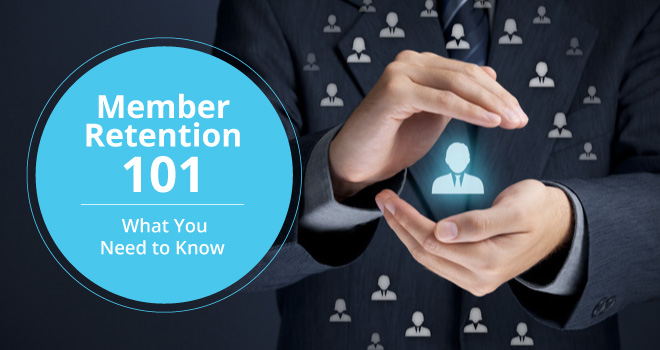-
Software
Compliance Software
Oversee licenses, track renewals, access documents, and more from a single interface.
Software Overview -
Services
Compliance Services
Full service compliance solutions for organizations throughout their entire lifecycles.
Services Overview -
Industries
-
Partner
- Information Center
Member Retention 101: What You Need to Know
Posted on February 24, 2020 by Harbor Compliance in Nonprofit Compliance.

If you run an association, you already know that your members are your number one priority. Associations provide a valuable space for members to come together, learn from each other, and network.
Good indicators of your association’s success are your member retention and member acquisition rates. These rates reflect how often existing members are renewing their membership and the frequency of new members joining.
It’s commonly known that member retention is more valuable than member acquisition. For starters, it’s more affordable to focus on keeping your current members than exhausting efforts to attract new ones. Additionally, high member retention rates reflect how dependable your association is. People want to join associations with large and stable memberships. This means that there are more members to meet and learn from.
An association with a consistent or growing member retention rate can in turn help accelerate your member acquisition rate. The more reliable your association membership is, the easier it is to expand. A loyal and dependable membership is the best foundation to build on and speaks highly about your association in general.
If you want to nurture your membership, take a look at how you’re currently spending your free time and review your member retention strategies. That’s why we put together this guide of common questions to consider when aiming to increase your retention rates. Focus on these questions:
- Why is member retention important?
- How can member engagement affect your retention rates?
- What are some member retention strategies?
With capable association management software and a fleshed-out member engagement strategy, your association can improve member relationships and ultimately raise member retention and acquisition rates. Let’s get started!

1. Why is member retention important?
According to Qgiv, donor retention rates are one of the top priorities for nonprofits. This same mindset should be applied to associations. Just like how donors contribute gifts, members must pay dues. To encourage membership renewal, your association should offer experiences and create an environment that exceeds the value of those dues.
Take a look at your data and consider your members’ needs and how your association can meet them. Member retention depends on member satisfaction, which can affect your association in other positive ways than just easing the stress of managing your membership.
For instance, enhancing your member retention strategies can:
- Help fund your association. Without a steady member retention rate, your association has to expend extra resources and funds to continue existing. Member dues are your most consistent sources of revenue and help support general association upkeep such as staff pay and office management. Additionally, it’s way more expensive to try and attract new members. Think of advertising and marketing costs, as well as research costs for member acquisition.
- Improve your reputation and standing. The more you focus on member retention, the more your association develops the reputation of being reliable and valuable to its members. After all, members don’t stick with an organization for no reason. This shows others that your association is actually worth joining. If existing members continue to engage with your association’s events and grow from various opportunities, others will take notice.
- Increase positive referrals. A boost in member retention rates brings an increase in positive referrals! If individuals are renewing their memberships and continuing to pay their dues, that means that they actively enjoy being a part of your association. This can be due to the experiences you offer, the online engagement tools you provide, or the relationships you’ve developed. These current members are more likely to express a positive experience to those who might want to join.
- Keep your services true to your association’s mission. Your association’s mission should be based on providing the best services for your current members. Associations often get caught up in how they can attract more members, but it’s important to keep your core mission top-of-mind.
Member retention is an active and consistent effort. While a satisfied and fulfilled member is less likely to churn out, there are still a myriad of reasons why individuals might not renew. Whether those reasons are personal or financial, it’s imperative that you take the time to develop your member retention strategies year after year. This is usually done by pinpointing areas of high member engagement, which we’ll explain next.

2. How can member engagement affect your retention rates?
Member engagement encompasses the entire relationship your association maintains with your members. This includes every email, member action, internal member interaction, and more. It’s important to remember that no two associations are alike, so the way associations track member engagement will differ as well.
According to this Fonteva guide, the best way to define what engagement means to your association is to see where your members are already active. How can you do this? Consider the experiences and opportunities your association already offers. Using a data-driven approach, determine how your members currently engage with them.
Many organizations benefit from tracking their data effectively, and your association can too. For example, a good place to start looking is your:
- Social media platforms. How often are your members interacting with you on social media?
- Email open rate. How many members are actually opening your emails?
- Event attendance. How many members are registering for your events?
- Learning management system. Which learning opportunities and online courses are your members signing up for?
These are all helpful places to get a better sense of where your members are engaging the most. If there is high member engagement, you can confidently conclude that a member is happy.
When members actively engage, this shows that they enjoy your association and are putting in the extra effort to be a part of it. High member engagement is a key indicator of the value that outweighs membership dues.
To effectively track member engagement, it’s smart to invest in a software solution that can help you view engagement holistically and set specific key performance indicators and goals. Having a capable membership management tool by your side will help improve your engagement efforts and may highlight additional opportunities.

3. What are some member retention strategies?
Once you determine where your members are already most active, you can work on developing those engagements and incorporating them into your member retention strategies. Further expand these areas of high member engagement and consider new ways that you can improve areas with lower engagement data.
Although each association’s membership and engagement are different, there are a couple of core strategies that can help any association’s member retention rates. Think about ways to improve by learning more about your members and investing in tools to help you leverage those engagements. Here are some options:
- Send out surveys. It’s always a good idea to present a dependable line of communication between you and your members. This way, members can relay their feedback through a consistent, reliable platform. Consider distributing surveys after events, during membership renewals, and at the end of the year. Ask your members to be honest in telling you what they want, and you will gain a better understanding of what you’re doing well and what you can improve.
- Optimize your event planning. In-person meetings and live events offer unique learning experiences and networking opportunities, ultimately reminding members of the value of their community. Event management tools are especially helpful here. Make sure that your AMS can set up a dedicated event page for better marketing, facilitate a seamless registration process, and manage all event logistics from one easily accessible place.
- Give members the tools they need to engage with each other. Your association’s website can encourage online engagement with an accessible and user-friendly member portal. Members can browse other member’s profiles, learn about each other, and communicate via forums. Your best bet is to find website builders that are specifically designed for memberships.
- Segment members for targeted communication. Since each member is unique, your communication strategies should be tailored accordingly. Consider segmenting your members based on their interests and preferences. This way, you ensure that members are receiving messages and announcements in the way that they prefer. For example, if they only want emails and not physical newsletters, make sure you adhere to that.
These strategies will help all associations enhance the member experience. More customized online engagements and stronger events will ultimately grow your association’s membership.
Member retention is critical for all associations. It speaks to how successful the association is and whether it’s worth joining. By considering where your members are already active, you can leverage that engagement to improve member relationships and your retention rates. Good luck!
Harbor Compliance does not provide tax, financial, or legal advice. Use of our services does not create an attorney-client relationship. Harbor Compliance is not acting as your attorney and does not review information you provide to us for legal accuracy or sufficiency.

Jake Fabbri is the Vice President of Marketing at Fonteva with over 18 years of experience working in marketing management. He has experience with lead generation, content marketing, marketing automation, and events.





